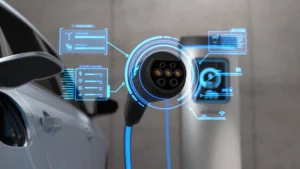As electric vehicles (EVs) become more mainstream, understanding the nuances of charging technology is crucial for maximizing convenience and efficiency. EV owners often face the choice between AC (Alternating Current) and DC (Direct Current) charging. This article delves into the benefits and drawbacks of both methods, providing insights to help you determine the best charging solution for your needs.
Understanding AC Charging
AC charging is the most common method used in residential and commercial settings. When an EV is plugged into an AC charger, the electricity is converted from AC to DC by the vehicle’s onboard charger before being stored in the battery.
Key Points of AC Charging:
- Residential and Public Use: AC charging is typically available in homes and many public locations. It operates at a lower voltage (120V or 240V), making it suitable for overnight charging or situations where extended parking is available.
- Charging Times: Depending on the charger and vehicle, AC charging can add between 10 to 60 miles of range per hour. This method is slower compared to DC charging but is adequate for daily commuting needs.
Understanding DC Charging
DC fast charging delivers direct current directly to the vehicle’s battery, bypassing the onboard charger and significantly speeding up the process. This method is typically found in commercial fast-charging stations along highways and major routes.
Key Points of DC Charging:
- High-Speed Charging: DC chargers operate at a higher voltage (400V to 800V), providing up to 80% charge in 20-30 minutes. This rapid charging capability makes it ideal for long-distance travel and quick top-ups.
- Public Infrastructure: DC fast chargers are becoming more widespread, especially along highways and at travel centers, addressing range anxiety and supporting long journeys.
Benefits of AC Charging
AC charging offers several advantages, particularly for everyday use:
Cost and Accessibility:
- Lower installation and equipment costs make AC charging more accessible for residential use.
- Widely available in public settings, such as shopping centers, workplaces, and parking garages.
Battery Health:
- The slower charging process generates less heat, reducing stress on the battery and potentially extending its lifespan.
- Lower charging currents minimize the risk of overcharging and thermal runaway, promoting safer battery operation.
Benefits of DC Charging
DC charging provides distinct benefits, especially for specific scenarios:
Speed and Convenience:
- Significantly reduces the time required to recharge, making it essential for long-distance travel or situations where time is limited.
- Quick charging sessions enable high vehicle utilization for commercial fleets and rideshare services, minimizing downtime.
Public Infrastructure:
- The growing network of DC fast chargers enhances the convenience and feasibility of owning an EV, addressing range anxiety for potential buyers.
- Fast chargers at strategic locations, such as highways and travel centers, provide essential support for long trips, ensuring that drivers can recharge quickly and continue their journey.
Potential Downsides of AC Charging
Despite its advantages, AC charging has some limitations:
Long Charging Times:
- The extended duration required to reach a full charge can be inconvenient, especially for drivers with limited access to overnight parking or charging facilities.
- Less practical for long-distance travel where quick top-ups are necessary to maintain travel schedules.
Infrastructure Limitations:
- Limited by the electrical capacity of residential settings, which can restrict the charging speed.
- Public Level 2 chargers may not be as widely available or conveniently located as fast charging stations, limiting their practicality for on-the-go charging.
Potential Downsides of DC Charging
DC charging, while beneficial, also presents certain challenges:
Higher Costs:
- Public fast charging stations often charge higher rates for electricity compared to home charging, increasing the cost per mile.
- Installing and maintaining fast chargers involves significant upfront investment and ongoing operational expenses, making them less accessible for some businesses and homeowners.
Battery Degradation:
- Frequent exposure to high currents can accelerate battery wear and reduce overall battery lifespan, impacting long-term performance.
- Increased heat generation during fast charging can exacerbate battery degradation if not properly managed.
Practical Considerations for EV Owners
Choosing between AC and DC charging depends largely on individual driving habits and specific needs.
Daily Commutes and Short Trips:
- AC charging is suitable for regular daily use, offering cost efficiency and the convenience of home charging setups. It is ideal for overnight charging, ensuring the vehicle is ready each morning.
Long-Distance Travel and Commercial Use:
- DC charging benefits long trips and commercial fleet operations, providing rapid recharges and reducing downtime. The presence of strategically located fast chargers supports seamless long-distance travel.
Technological Advancements
Ongoing advancements in battery and charging technology are enhancing the viability of both AC and DC charging methods.
Improvements in Battery Technology:
- Developments in battery chemistry are reducing degradation risks, making fast charging more sustainable.
- Enhanced battery management systems optimize charging rates and monitor health, mitigating adverse effects.
Infrastructure Development:
- The expansion of DC fast charging networks is making rapid charging more accessible.
- Innovations in AC charging technologies are improving efficiency and reducing installation costs.
Conclusion
The decision between AC and DC charging for EVs involves weighing various factors, including cost, convenience, and battery health. AC charging is beneficial for regular use, offering cost efficiency and extended battery life. In contrast, DC charging is indispensable for long trips and quick recharges. A balanced approach that leverages both methods based on specific needs can maximize the benefits of EV ownership. As the EV market evolves, understanding and optimizing charging practices will be crucial for a sustainable and efficient driving experience.




